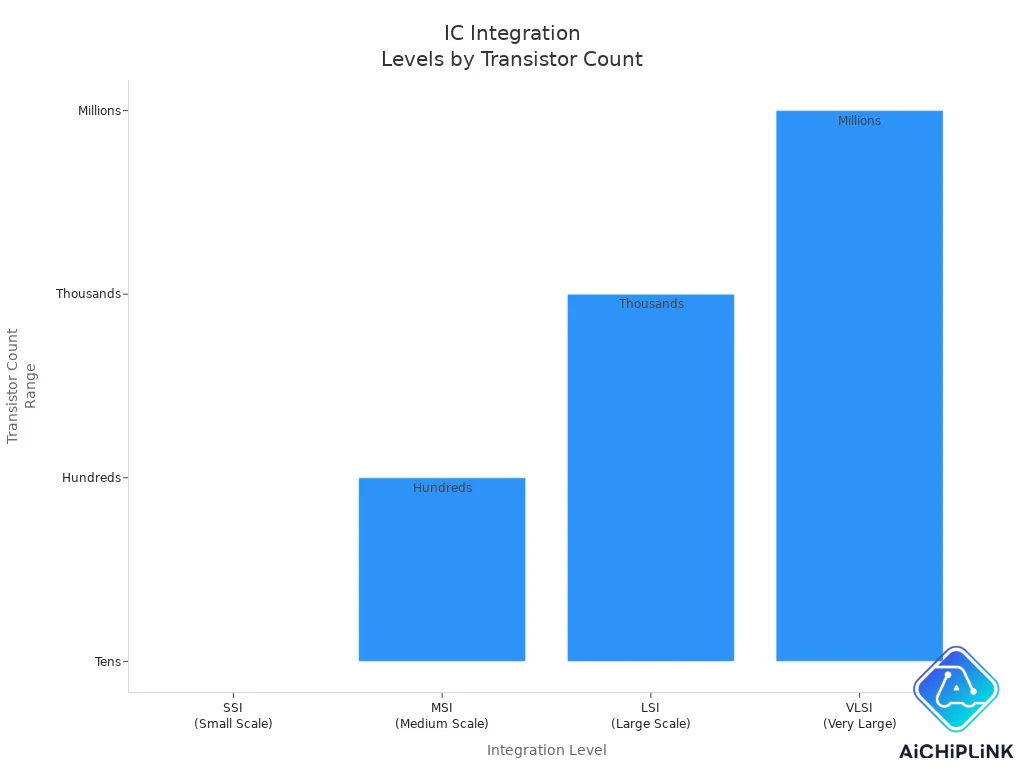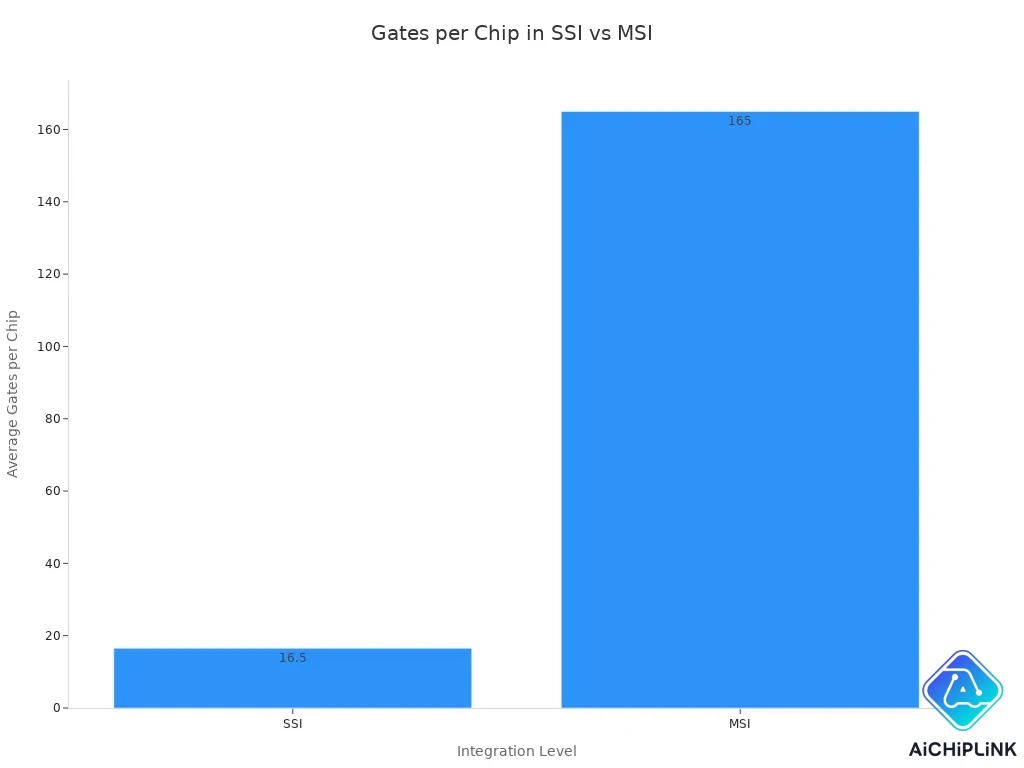
The difference between msi and ssi comes down to the number of logic gates inside each chip. You see the difference between msi and ssi when you look at how many functions each one can handle. MSI chips hold more logic gates and can do more complex tasks. SSI chips have fewer gates and work for basic functions.
Key Takeaways
- SSI chips have less logic gates and do easy jobs like simple AND, OR, and NOT functions. MSI chips have more gates and can do harder jobs like counting, adding, and saving data. Using MSI chips helps make digital devices smaller, faster, and more dependable than using lots of SSI chips. Picking the right chip type saves space and power and helps circuits work better. Knowing about SSI and MSI helps you learn harder electronics later.
Definitions
What is SSI?
SSI is the first kind of integrated circuit. SSI means small scale integration. This chip has only a few transistors or logic gates. Most SSI chips have 1 to 10 transistors. They can only do simple jobs. SSI is used in easy logic circuits, like AND, OR, or NOT gates. These chips became popular in 1964. They were important for early computers and space technology.
Here is a table that shows the main features of SSI:
| Integration Scale | Definition Summary | Approximate Year Introduced | Transistor Count Range | Logic Gate Count Range |
|---|---|---|---|---|
| SSI (Small-Scale Integration) | Circuits with a small number of transistors or logic gates | 1964 | 1 to 10 | 1 to 12 |
Note: SSI chips are a kind of integrated circuit. All the parts inside are joined so closely you cannot take them apart.
What is MSI?
MSI means medium scale integration. MSI comes after SSI. These chips have more logic gates, usually 30 to 300. MSI made it possible to build harder circuits on one chip. You can find MSI in things like calculators, counters, registers, and early microprocessors. MSI became common in the late 1960s and early 1970s. It let engineers make chips that could do more than just simple logic.
Medium scale integration and medium-scale integration both mean this chip type. MSI helped fill the space between SSI and more advanced chips.
Below is a chart that shows how SSI and MSI fit into the bigger picture of integrated circuits:

As technology got better, chips had more transistors. SSI and MSI led to even bigger chips. Knowing about these two types helps you see how digital devices got stronger over time.
Difference Between MSI and SSI
Components
When you compare msi and ssi, you notice the number of parts inside each chip is different. SSI chips have only a few logic gates and transistors. MSI chips have a lot more inside. You can see this in the table below:
| Integration Level | Gates per Chip Range | Typical Number of Transistors per Chip |
|---|---|---|
| SSI | 3 – 30 | 1 to 100 |
| MSI | 30 – 300 | 100 to 1000 |
SSI chips usually have simple logic gates or easy circuits. You might find AND, OR, or NOT gates, or a few flip-flops. MSI circuits have more advanced parts. These can be counters, multiplexers, adders, or even small microprocessors.
Here is another table that shows what you might find in each type:
| Integration Scale | Common Components Integrated |
|---|---|
| SSI | Logic gates, Operational Amplifiers, Flip-flops |
| MSI | Counters, Multiplexers, Adders, 4-bit Microprocessors |
Note: MSI circuits use more transistors and gates. This lets you build more complex digital systems on one chip.
You can also see the difference in the number of gates per chip in this chart:

Complexity
How hard each chip is to understand is another big difference. SSI chips do simple logic jobs. You use them for easy things, like turning something on or off. MSI circuits can do much more. With medium scale integration, chips can do many steps or mix lots of logic jobs together.
-
SSI chips:
-
Simple design
-
Less than 30 gates
-
Easy to use and understand
-
-
MSI circuits:
-
More complex design
-
30 to 300 gates
-
Can do many logic jobs in one chip
-
MSI technology helps you make digital systems smaller and faster. They are also more reliable than using lots of SSI chips. With medium-scale integration, you need fewer separate chips. This makes your circuits easier to fix and less likely to break.
MSI circuits also use less power and take up less space than using many SSI chips for the same job.
Functions
The jobs each chip can do show the biggest difference between msi and ssi. SSI chips do basic logic. You use them for simple gates and small circuits. MSI circuits can do harder digital jobs.
Here is a side-by-side comparison:
| Integration Scale | Typical Functions | Example Components |
|---|---|---|
| SSI | Basic logic (AND, OR, NOT, NAND, NOR, XOR, XNOR) | 7400 Quad NAND Gate, LM324N Op-Amp |
| MSI | Adders, counters, multiplexers, decoders, small microprocessors | SN74LS93N Counter, 4-bit ALU |
-
SSI chips:
-
Do basic Boolean logic
-
Used for simple choices in circuits
-
-
MSI circuits:
-
Do harder jobs like counting, adding, or picking data
-
Used in calculators, digital watches, and early computers
-
With msi technology, you can make circuits that do more than just basic logic. MSI circuits help you build devices that can process information, store data, and control other things. Medium-scale integration fills the gap between simple SSI chips and bigger, more advanced chips.
If you want to make a circuit that does more than basic logic, you need MSI circuits. They let you build smarter and more useful digital devices.
Use Cases
SSI Applications
SSI chips were used in the first digital devices. They do simple logic jobs. You could find them in old calculators and clocks from the 1960s. SSI chips helped make big circuits much smaller. This made early computers smaller and more dependable.
Here is a table that shows how SSI chips are used in real devices:
| Integration Scale | Years | Transistor Count per Chip | Common Applications |
|---|---|---|---|
| SSI | 1961-1965 | 10 to 100 | Basic logic gates, flip-flops in calculators, clocks |
People use SSI chips for easy logic work. For example, they turn lights on or off or help a circuit make a simple choice. These chips were the start of better digital systems.
Tip: SSI chips are best if your circuit only needs a few logic gates.
MSI Applications
MSI circuits let you make more advanced digital devices. You can find msi circuits in clocks, calculators, and old computers. These chips can count, store data, and pick signals. MSI circuits make devices work faster and take up less space.
Here are some ways people use msi circuits:
-
Digital clocks use msi circuits to count time.
-
Calculators use msi circuits for math and logic.
-
Computers use msi circuits to store data and pick signals.
-
Factories use msi circuits to control machines and handle data.
This table shows how msi circuits are used in different systems:
| MSI-Based System | Function | Common Applications |
|---|---|---|
| Counters | Counting clock pulses | Frequency dividers, clocks |
| Registers | Data storage | Computers, digital devices |
| Multiplexers | Selecting input signals | Data transmission, processing |
| Arithmetic Logic Units (ALUs) | Arithmetic and logic operations | Computers, calculators |
MSI circuits help you make devices that do more than just basic logic. You can build digital watches, timers, and small computers. These circuits were a big step in electronics because they put more jobs into one chip.
Note: MSI circuits are still used in home gadgets and factories. They help you make smarter and better devices.
Importance
Avoiding Confusion
You need to know the difference between SSI and MSI to avoid mistakes when working with digital circuits. If you mix them up, you might choose the wrong chip for your project. This can lead to circuits that do not work as planned or waste space and power. Understanding each type helps you pick the right part for the job.
When you learn about SSI and MSI, you build a strong foundation for more advanced electronics. SSI chips teach you the basics of logic gates and simple circuits. MSI chips show you how to handle more complex tasks, like counting or storing data. This knowledge helps you understand how technology moved from simple to more powerful systems, including large scale integration.
Here are some reasons why this knowledge matters:
-
You can design circuits that use fewer parts and work better.
-
You avoid using too many chips, which saves space and power.
-
You learn how digital devices became smaller and more reliable over time.
-
You get ready to study even more advanced chips in the future.
Making Choices
When you design or fix a circuit, you must choose the right type of chip. Knowing the difference between SSI and MSI helps you make smart choices. You can match the chip to the job you need to do.
| Decision Point | Why It Matters |
|---|---|
| Picking SSI or MSI | Ensures your circuit is simple or complex enough |
| Saving space and power | Helps you avoid extra parts and wasted energy |
| Learning progression | Prepares you for working with more advanced chips |
In electronics classes, you often start with SSI to learn basic logic. Then, you move to MSI to see how circuits can do more. Teachers use both types to help you understand how digital systems grow in complexity. You also practice designing, building, and fixing circuits with these chips. This hands-on work makes you a better engineer or hobbyist.
Tip: Always check what your circuit needs before picking a chip. This habit will help you avoid confusion and make your projects more successful.
You now know that MSI chips have more logic gates and handle more complex tasks than SSI chips. This difference helps you choose the right chip for your project. When you understand how SSI and MSI work, you build better circuits and avoid mistakes. You also get ready to learn about large scale integration and even more advanced technology. Use this knowledge to make smart choices in your electronics work.
FAQ
What does integration mean in electronics?
Integration means putting many electronic parts, like transistors and gates, into one chip. You use integration to make circuits smaller and faster. This helps you build better digital devices.
Why did engineers move from SSI to MSI?
You get more functions with MSI chips. Engineers wanted to make circuits that could do more jobs without using many chips. MSI made devices smaller, faster, and easier to build.
Can you mix SSI and MSI chips in one project?
Yes, you can use both SSI and MSI chips together. You might use SSI for simple logic and MSI for more complex tasks. This helps you design circuits that fit your needs.
What comes after MSI in integration levels?
After MSI, you find large scale integration. This level puts thousands of gates on one chip. You use large scale integration for advanced devices like computers and smartphones.

Written by Jack Elliott from AIChipLink.
AIChipLink, one of the fastest-growing global independent electronic components distributors in the world, offers millions of products from thousands of manufacturers, and many of our in-stock parts is available to ship same day.
We mainly source and distribute integrated circuit (IC) products of brands such as Broadcom, Microchip, Texas Instruments, Infineon, NXP, Analog Devices, Qualcomm, Intel, etc., which are widely used in communication & network, telecom, industrial control, new energy and automotive electronics.
Empowered by AI, Linked to the Future. Get started on AIChipLink.com and submit your RFQ online today!